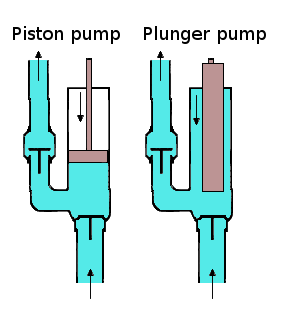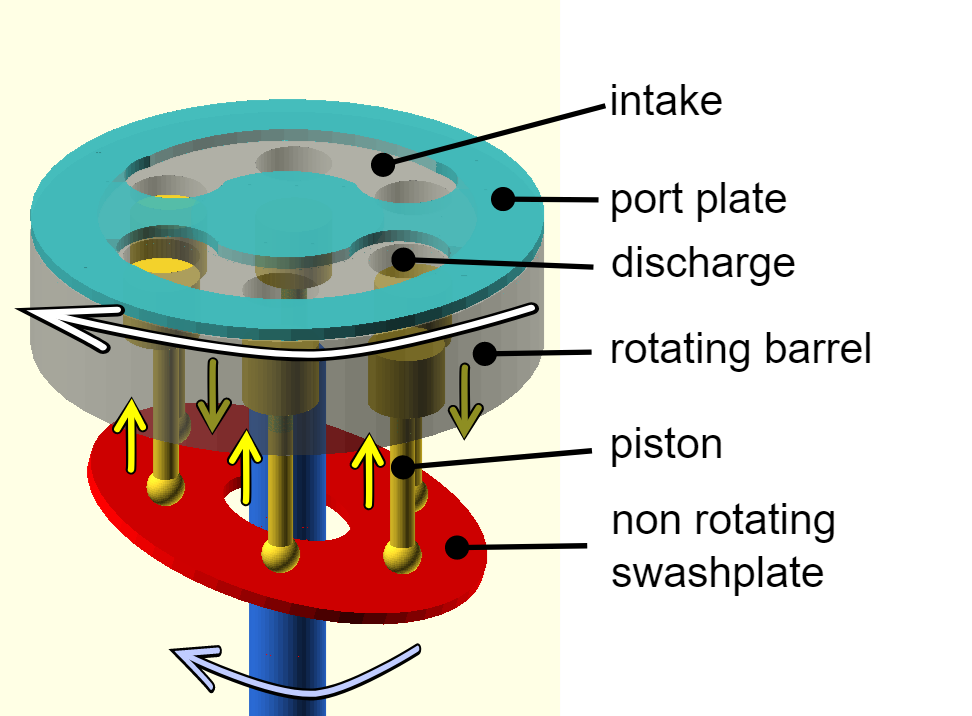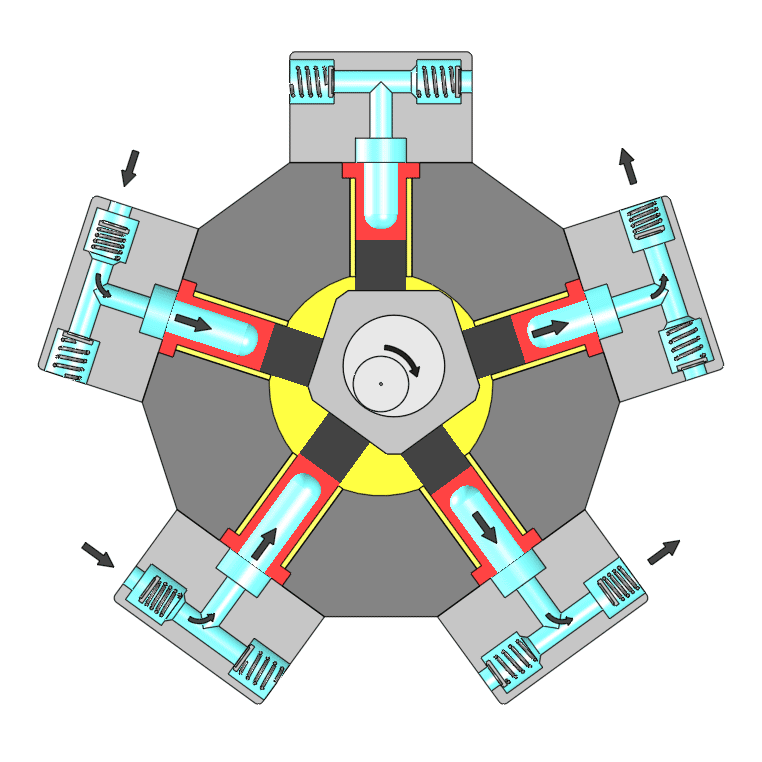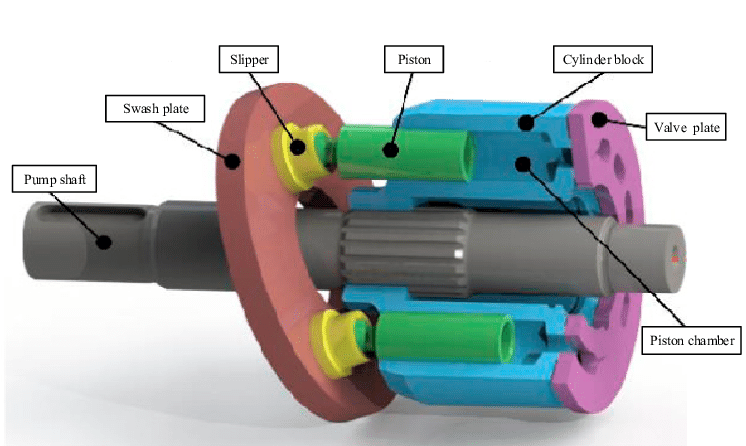Parts of Piston Pump – The high-pressure seal reciprocates with the piston of a piston pump, which is a form of positive displacement pump. Piston pumps can be used to compress or transfer liquids. They may work under a variety of pressures. High-pressure operation is possible without having a significant impact on flow rate. Piston pumps can also handle viscous and solid-particle-containing fluids. This pump works by using a piston cup, an oscillation mechanism in which down-strokes generate pressure differentials, the filling of pump chambers, and the pump fluid being forced out for usage. Piston pumps are frequently employed in applications that need high, continuous pressure such as water irrigation or delivery systems.
The Linquip website is a great place to get all the answers to your questions related to a piston pump. There is a team of professional experts who would be delighted to answer any questions you may have concerning piston pumps and are ready to assist you at any time. As the first point of reference, you might want to check out Linquip’s article titled “What is Piston Pump & How Does It Work?” to gain a basic understanding of the way in which this type of positive displacement pump works.
Have you ever worked with piston pumps before? With Linquip you will find an extensive selection of Piston Pumps Products, with the assistance of which you will be able to locate the product that meets your needs. Buying a piston pump right now? Need assistance? The Linquip website gives you free access to the entire Linquip database of all available Piston Pumps for Sale. As an added benefit, Linquip is a platform that provides clients with an efficient resource for getting a free quote on the price of piston pumps from all the available Piston Pumps Suppliers and Companies.
⇒ View a Comprehensive List of Piston Pumps for Sale and Their Suppliers ⇐
What is A Piston Pump?
A piston pump is a type of reciprocating pump that uses one or more reciprocating pistons to move and pressurize fluid. Every piston pump contains three major components: a piston, a crank, and inlet and exit valves. The piston is the major source for enabling liquid to flow in and out through the valves. The crank, which is connected to the motor, will rotate, allowing the piston to move back and forth repeatedly. Finally, there will be an inlet and output valve for each piston pump. The liquid or gas can enter and escape the cylinder through these two valves.
Pistons will initially move upward, allowing liquid or gas to be sucked in from its input valve, whether powered by an electric motor, internal combustion engine, or less advanced possibilities like hand, wind, or running water. The piston will go lower after the cylinder has been full. This downward motion increases the pressure on the outlet valve, which opens and lets high-pressure liquid or gas leave the cylinder. The rotating action of the crank will cause a repeating back and forth motion after the piston has reached its maximum extent.

Various Types of Piston Pump
A lift pump and a force pump are the two most common types of piston pumps. The upstroke of the piston of a lift pump draws water from the inlet valve into the lower half of the cylinder. Water flows into the top half of the cylinder through valves in the piston on the downstroke. Then a second upstroke occurs allowing the cylinder’s medium to discharge via a spout from the upper half of the cylinder.
A force pump is similar to a lift pump in operation, with one minor variation. The piston’s upstroke brings water into the cylinder once again through the intake valve. The water is then released via the outlet valve into the output pipe with just one more downstroke. The lift pump requires the last upstroke to drive the medium out of the pump, whereas the force pump does not. To let water in, a force pump just requires one upstroke and one downstroke to force the medium out. The lift pump, as its name suggests, lifts the medium out with a second upstroke, whereas the force pump forces the medium out with a downstroke.
When it comes to piston pumps, there are more complex possibilities. Axial piston pumps and radial piston pumps are the two most prevalent types. The axial piston pump is a positive displacement pump, one of the most flexible piston pumps available. It can be configured as a pump or a motor, depending on the application. The axial piston pump may be used for a number of purposes when combined with a variety of control systems. The fundamental design provides efficient power delivery, which has led to an increase in the number of fixed displacement gear or vane pumps being specified.

Pumps that can only be operated by one piston, such as a lift or force pump, are not conventional piston pumps. Multiple pistons are arranged in a circular array within a cylinder block in an axial piston pump. This circular array of pistons revolves against a swash plate that is either inclined or stationary. The pistons are pushed forward and backward as the rotary group rotates. The way the fluid is pulled through the suction side of the pump and out through the pressure side is controlled by a grooved timing plate at the top of the pistons.
The radial piston pump, like the axial piston pump, has numerous pistons. It is distinguished from the others by the fact that its pistons are positioned radially around the driving shaft. The connecting rods drive the pistons back and forth in the cylinders as the shaft spins, creating the pumping motion. The task is accomplished after a 180-degree rotation angle, and the piston’s workspace is filled with the moving medium, which may now be expelled through the outlet valves.
Mineral oil, oil in water, biodegradable oil, water-glycol, synthetic ester, and cutting emulsion are all hydraulic fluids that may be utilized with a radial piston pump. Machine tools, high-pressure units, test rigs, automobile gearboxes, plastic, and powder injection molding, and wind energy are all frequent uses for radial piston pumps.
Piston Pump Parts
The construction of this pump is a little complicated, and there are relatively few clearances between its working parts. It ensures a consistent discharge at high pressure. Other variations are similar to this one but with small differences. As a result, it is critical to thoroughly examine each of its components. Let’s look at the components of a commonly used straight axis piston pump.
The housing is built of a rust-resistant and durable material, usually steel alloy. Valve plate, piston assembly, cylinder block, swashplate, shoe plate, and driven shaft are all stored here.
Cylinder Block
It’s attached to the driving shaft and spins at the same rate as the shaft. There are axial bores in this area. They are usually between the ages of 8 and 12. These bores move up and down as the piston goes up and down. This block has a little amount of clearance with the housing. The axis of this pump gives it its name. The driving shaft’s axis is the same as the cylinder block, hence it’s known as a straight axis piston pump. It features a valve plate attached to the intake and outlet ports on one end and a piston and swash plate assembly on the other.
Piston Assembly
The piston travels via the cylinder block’s axial bores. The shoe joint connects this piston to the shoe plate. On a swash plate, this shoe plate is attached.
The number of pistons in a car is usually between 8 and 12. It’s always an even number of them. They travel in an axial direction, which means they reciprocate in the axial bores.
Rotating Barrel
The piston assembly is housed in a spinning barrel. It features slots in which pistons are installed. It is built in such a way that as the turning barrel turns, so do the pistons. This mechanism aids in the fluid displacement in the piston pump.
Intake Port
This is the section where liquid or gas input is provided.
Discharge
This is the discharge side of the system.
Port Plate
The port plate is another significant component that separates the fluid from the intake and discharge ports. The working fluid must flow through this port plate, whether it is a liquid or a gas.
Shaft
Like all other types of pumps, the shaft is the most important component of piston pumps. It has a spinning barrel as well as a swashplate. Let’s attempt to figure out what a swashplate is.
Swash Plate
The shoe plate is the one to which a spherical joint/shoe joint connects pistons. The swash plate is then attached to this shoe plate. This plate is attached to the axis of rotation at a specified angle. It gives the shoe plate an angle, which impacts the pump’s discharge. As a result, as we adjust this angle, the pump’s discharge varies as well.
The Significance of a Swash Plate
- To make a modification in the pump’s discharge.
- Changing the angle of the swash plate to modify the length of the pump’s stroke.
Changing angles is all it takes to do this. There will be no suction and no discharge if the swash plate is perpendicular to the axis. This is because the piston’s stroke length will be minimal, and it will occupy the bore in the cylinder, leaving no room for fluid to enter or depart. As a result, the piston will remain stationary and the entire system will continue to rotate.
When the angle is slightly inclined, the pistons will now reciprocate because their stroke length will change as the cylinder block rotates. As a result, the bore becomes empty, allowing liquid to be sucked and pushed out through the delivery port. The amount of space generated in the bore is proportional to the amount of piston movement out of the cylinder when coupled to the swash plate. The length of the stroke is hence directly connected to this gap. The angle of the swash plate is proportional to the stroke length. As the swash plate becomes more angled, the piston moves further away from the bore, producing more room and, as a result, greater discharge. As a result, the angle of the swash plate is critical in this pump.

How Do Piston Pumps Work?
Principles of Operation
We’ve previously seen that there are a few different types of piston pumps; now, let’s look at the operating principle of straight axis piston pumps.
To grasp the notion, first master the basic functioning principle of piston pumps. Following this part, we’ll go through the principles of operation for each type of piston pump.
The following is the working principle:
- The piston pump, being a positive displacement pump, generates high pressure by piston movement.
- For piston motion, the pump is linked to a power supply.
- The number of pistons required is determined by the application and pressure requirements.
- To manage the flow as well as the state of the flow, a controlling device is required.

To find out more about the working principle of a piston pump, watch this comprehensive video.
Let’s take a look at each type of piston pump, its parts and how they function.
Function of Piston Pumps
The prime mover is responsible for providing haft power to the drive shaft. When the driving shaft rotates, the cylinder block attached to it rotates as well. The piston assembly revolves in tandem with the cylinder. However, because pistons are linked to shoe plates at an angle, they will begin to reciprocate at their current position and perform the sliding motion. When the swash plate is close to the cylinder block, the piston will take up more space in the cylinder bore, however, when the swash plate is far away from the cylinder block, the piston will be drawn out of the bore towards the swash plate since they are connected to it. Because the shoe plate rotates with the cylinder block, some pistons are in the bore at any one moment, which is employed to produce a pressure differential that allows fluid to be sucked in and pumped out.
As a result, when the pistons are moved to the opposite end of the swash plate, fluid is sucked in through the suction port in this empty bore. The piston travels inwards as the cylinder block rotates, and at this position, the piston slides into the bore to force fluid out. This action occurs concurrently, with some pistons sucking and others pushing fluid out, resulting in a smooth and continuous discharge.
Why Should You Use a Piston Pump?
These pumps have a high-pressure rating of up to 850 bar and a decent discharge rate of up to 45 m/s. They have high volumetric efficiency as well.
Piston Pump Materials
Different materials are utilized in piston pumps, depending on the project needs as well as the sorts of applications.
When choosing materials, keep two things in mind: the casing and cylinder materials must be strong enough to withstand the working pressure and temperature.
- Sturdy structure
- Resistance to scratches
- Chemical attack resistance
- Free of rust and corrosion
For a fundamental understanding, just a few types of materials have been listed below:
- Stainless steel is a durable material.
- Brass
- Alloy of nickel
- Iron (cast)
- Plastic
- Ceramics
- Aluminum
- Bronze
Benefits of a Piston Pump
The following are some of the benefits of piston pumps:
- Suitable for fluids with a high viscosity.
- The pace is slow.
- High productivity.
- There is a large pressure range.
- The Head has no influence on pump discharge.
- Pumps for metering are widely used.
- When there is no flow, it is normally exceptionally difficult to regulate the force. Force, on the other hand, may be simply regulated without any flow for this sort of pump.
- The pressure of the liquid or gas has no influence on pump performance.
- It can handle abrasives, slurries, and other abrasive materials with ease.
Piston Pump Disadvantages
The following are the drawbacks of the piston pump:
- This pump is rather large.
- Because of the piston assembly, it’s rather large.
- They are typically used for low fluid flow rates.
- Because the flow is pulsing, a pulsation dampener is necessary.
- The expense of upkeep is high.
- Operating costs are high.
Applications of Piston pumps
The piston pump can be used for the following purposes:
- System of irrigation
- Spray cans of paint
- Fertilizer manufacturing
- Treatment of wastewater
- Drilling
- Industries that produce oil
Conclusion
A piston pump is a reciprocating pump that uses one or more reciprocating pistons to transfer and pressurize fluid. Inlet and exit valves, a piston, a crank, and a piston are the only parts of a piston pump that never change. The various parts of a piston pump have been described in detail here. You are encouraged to visit Piston Pump For Sale in Linquip website to find suitable devices based on your application.
FAQs about Piston Pumps
1. When would you use a piston pump?
Piston pumps can transport liquids, pressurized gasses, viscous media, and media containing solid particles, among other things. Piston pumps are used in hydraulics for water and oil, industrial processing equipment, high-pressure cleaning, and liquid pumping.
2. Are piston pumps easy to maintain?
Because the mechanism isn’t very intricate, piston pump maintenance is often straightforward. Your whole line should be maintained on a regular basis, but the pump is an excellent place to start. Its basic mechanical motion is responsible for so much. It deserves to be treated as significant as it is.
3. How many pistons can piston pumps have?
Axial piston pumps contain nine pistons rotating around a central driving shaft. The pistons are forced to travel up and down along the pump axis when they revolve against a swashplate or bent axis. The pistons withdraw, allowing fluid to fill the expanding volume under the reservoir pressure head.
4. How efficient is a piston pump?
The total efficiency is observed to decrease significantly when the displacement decreases. Under pressure situations ranging from 5 to 35 MPa and displacement ranging from 13 percent to 100 percent of full displacement, volumetric losses vary from 13 percent to 47 percent of total pump power losses at rated speed.
5. What factors affect the performance of a piston pump?
Surface roughness; internal clearances; mechanical losses, such as those associated with lip seals, bearings, mechanical seals, and packing; impeller trim; high suction specific speed; and the viscosity of the fluid pumped are all important variables impacting pump performance.
Download PDF for Parts of Piston Pump
This document is available to download as a PDF, making it easy for you to access whenever you need it. Start by clicking the link below.
Buy Equipment or Ask for a Service
By using Linquip RFQ Service, you can expect to receive quotations from various suppliers across multiple industries and regions.
Click Here to Request a Quotation From Suppliers and Service Providers
Read More on Linquip
- Top Dosing Pump Manufacturers and Suppliers in 2022
- Top Water Pump Manufacturers and Suppliers in 2022
- The 7 Best RV Water Pump In 2022 (Clear Guide + Review)
- The 10 Best Electric Air Pump in 2022 (Clear Guide)
- The Best HVAC Vacuum Pump in 2022 (Clear Guide)
- 9 Different Types of Rotary Pumps + PDF
- The 5 Best Well Pump in 2022 (Clear Guide)
- The 10 Best Condensate Pumps of 2022: A Complete Guide
- 13 Parts of Concrete Pump with Name & PDF
- 5 Types of Concrete Pumps + PDF
- 6 Parts of Pool Pump + Diagram & PDF
- 20 Parts of Submersible Pump + PDF
- 12 Parts of Sump Pump + Diagram
- 8 main Parts of Piston Pump and Function + Work & PDF
- 7 Parts of Screw Pump: Advantages and Disadvantages
- 10 Parts of Hydraulic Pump + PDF & Function
- 7 Parts of Gear Pump and Function + Diagram & Applications
- 10 Parts of Reciprocating Pumps + Function, Application and Working
- Parts of Oil Pump
- Parts of Water Pump
- Parts of Centrifugal Pumps
- Types of Piston Pumps
- Types of Centrifugal Pumps: All Classification & Working Principles



